by Tamil Guardian, London, August 29, 2012
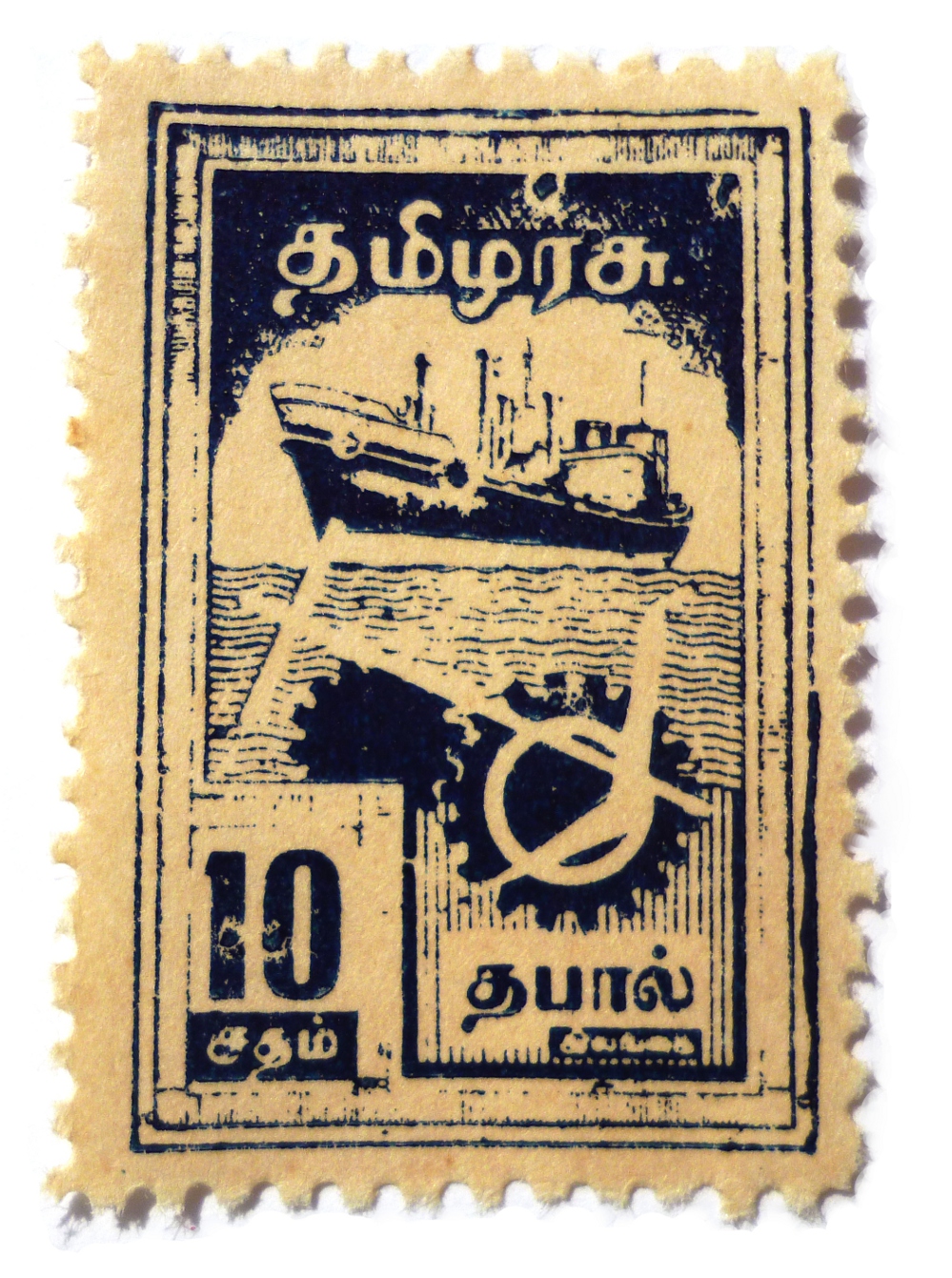
Postal stamp released by Ilankai Thamil Arasu Kadchi (Federal Party) on 14th April 1961 Photograph Tamil Guardia
Stamps such as the one above were produced by Tamil protestors during the mass civil disobedience movement of February to April 1961 when Tamils across the North-East united to oppose the Sri Lankan government’s rapidly escalating ‘Sinhala Only’ policies.
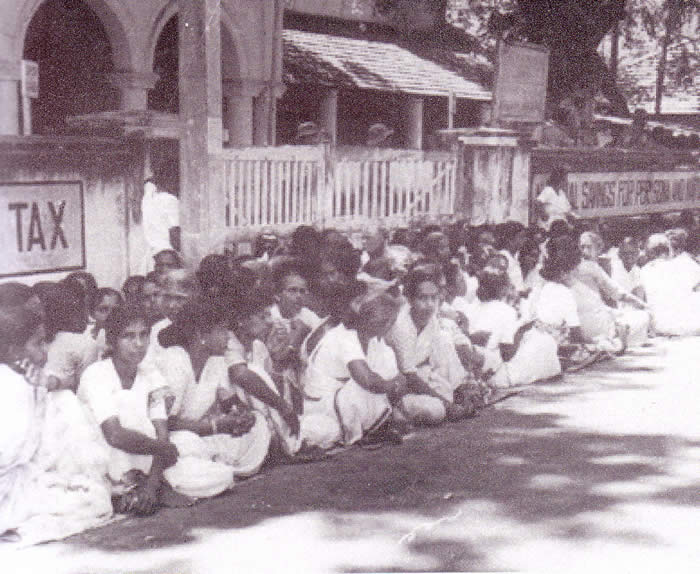
Satyagraha by Tamil women, Jaffna, 1961. Photograph Ilankai Tamil Sangam USA
The protests brought the civil administration in the Tamil speaking areas to a complete standstill by blockading government offices. They were triggered by the Sinhala government’s decision to forcefully implement the Sinhala Only act; the act had profound consequences meaning, for example, that the courts and police stations in the Tamil areas would henceforth function in Sinhala.
Protestors gathered in front of government buildings and as the momentum built, a festival-like atmosphere developed with people singing protest songs and listening to speeches by political leaders. By physically blockading the Sri Lankan state’s institutions, the protestors established an alternative space of Tamil freedom, in which the ideal of Tamil self-government became real and experienced. Furthermore the territorial reach of the protests, across the Tamil speaking North-East, marked out the territorial space of the Tamil nation.
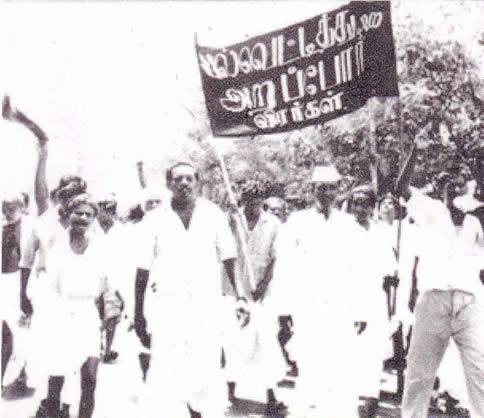
Tamil protest in Valvettithurai, April 1961. Photograph Ilankai Tamil Sangam USA
In an era before digital communication, the stamp was a crucial component of national and international communication and an appropriate vehicle for expressing national identity. In producing a stamp not only did the protestors express their aspiration for national status, but also the type of nation they wanted to establish.
The image of the ocean going ship on this stamp not only echoes the Tamils’ sea faring and trading past but also the desire for future economic modernisation, trade and development. The stamps were thus emblems of defiance, asserting a national identity in the teeth of Sinhala oppression but also, and importantly, expressing the aspiration to pursue economic development and prosperity.
According to V. Navaratnam, a Federal Party MP and the key instigator of the protest, most of the stamps produced during this period bore similar images of industrial development. Navaratnam conceptualised the design of the stamp as early as 1956, when he envisioned a parallel postal service for Tamils in defiance of the Sinhala state.
See here for more on V. Navaratnam, and here for an interview he gave to TamilNet in 2005, shortly before his death on 22nd Decemeber 2006.
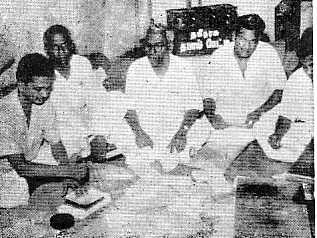
V. Navaratnam (pictured here in centre, wearing glasses) and fellow Tamil activists issue stamps, 1961. The photograph was published in the Federal Party Silver Jubilee Souvenier in 1974.
A crucial, if often overlooked, component of the Tamil nationalist project as it developed through the twentieth century is the identification of Tamil national interests with economic development. The two central Eelam Tamil nationalist organisations of the past century, the Federal Party and then the Liberation Tigers of Tamil Eelam (LTTE), both incorporated the economic and material development of the Tamil speaking regions as important components of their activities and demands. They both also argued that Tamil autonomy was the only solution to the Sri Lankan state’s systematic attempts to weaken and undermine Tamil economic capacity.
The compulsions of Sinhala oppression and Tamil resistance have hardly changed.
Sri Lanka finally crushed the protests in April 1961, with military force. Srimavo Bandaranaike’s government then went onto place the leaders of the Federal Party under arrest, including the FP’s charismatic leader SJV Chelvanayagam, who was at the time suffering from Parkinson’s disease.
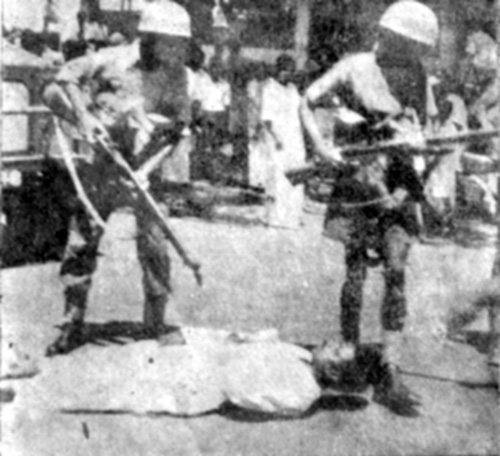
A Sinhalese soldier threatens protesting Tamil student, S.T. Arasu, who replied, “shoot me if you must, I am ready to die”. Photograph and source – ‘Satyagraha and the Freedom Movement of Tamils in Ceylon’ by S. Ponniah, 1963.
The government was eventually forced to release Chelvanayagam on account of his failing health, which required specialist care available in the UK. He was allowed to leave on condition that he did not meet members of the Tamil Diaspora. Chelvanayagam defied the conditions of his temporary reprieve and met the UK based Tamils, gaining strength and confidence from the meetings. The Tamil struggle at that stage was in the incipient stages of globalisation.
The Sinhala police destroyed much of Tamil struggle’s material culture from this period when it torched the Federal Party office and archives in 1981 in the infamous spree of arson attacks that also destroyed the Jaffna Public Library and its rich collection of books and rare manuscripts. The fire probably consumed the remaining records of the stamps and other artefacts such as periodicals, pamphlets and posters.
Nevertheless, the idea of Tamil territorial autonomy persisted and was given concrete form again through the de facto state that governed much of the Vanni and other LTTE controlled areas across the Northeast between 2001 and 2009. The de – facto state reaffirmed the aspiration for, and possibility of, Tamil freedom whilst also linking the Diaspora to the homeland – as thousands of west based Tamils flocked to participate in the new state’s economic and social development.
The material culture of the de facto state has also been obliterated by the Sinhala military. However, the shared memories and experience of its existence as well as the violent spectacle of its annihilation have galvanised a new global generation of Eelam Tamil activism.
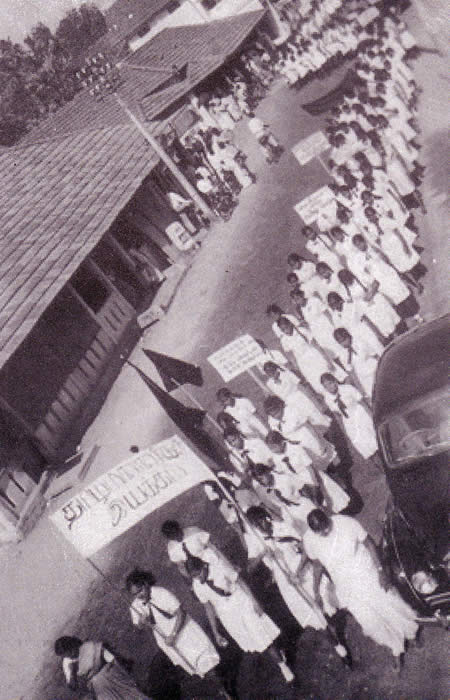
Tamil school girls march in protest, 1961. Photograph Ilankai Tamil Sangam USA
Stamps such as this are emblems of a crucial and formative moment in Tamil history. A moment of defiant civil disobedience that forged a Tamil Eelam national identity which then spread throughout the Northeast and was carried across the world by the Tamil Diaspora. It is an identity that has endured over successive generations, born long after the heady days of the 1961 protest.
–
References:
A key and primary source of Tamil politics during the Federal Party era is:
V. Navaratnam (1991) ‘The Fall and rise of the Tamil Nation: events leading to the Tamil war of independence and the resumption of Eelam sovereignty’
Also useful is:
A.J Wilson (1994) ‘S. J. V Chelvanayagam and the crisis of Sri Lankan Tamil nationalism , 1947-1977: a political biography.’
Authoritative accounts of the LTTE’s twin track political and military struggle for independence can be found in:
A.Balasingham (2003) ‘The will to freedom: an inside view of Tamil resistance’
A.Balasingham (2004) ‘War and Pace: armed struggle and peace efforts of the Liberation Tigers’
A recent first-hand account of the de facto state and its destruction can be found in:
N. Malathy (2012) ‘A fleeting moment in my country: the last years of the LTTE de Facto state’
See also a slightly earlier account of the de facto state in:
K.Stokke (2006) ‘Building the Tamil Eelam State: emerging state institutions and forms of governance in LTTE – controlled areas in Sri Lanka’ Third World Quarterly Vol 27 (6).